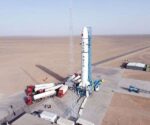At the AUSA 2025 Annual Meeting in Washington D.C., L3Harris Technologies and Carnegie Robotics unveiled the Diamondback — a next-generation unmanned ground vehicle (UGV) designed for tactical reconnaissance and multi-mission support. The platform underscores a growing trend in autonomous systems tailored to contested environments where human-machine teaming is critical.
Diamondback Overview: A Modular Reconnaissance Platform
The Diamondback is a tracked unmanned ground vehicle optimized for dismounted infantry support. Weighing approximately 1,000 kg with a payload capacity of up to 340 kg (750 lbs), it is engineered to operate autonomously or via teleoperation across complex terrain. The platform’s modularity allows it to be configured for ISR (intelligence, surveillance, reconnaissance), EW payloads, logistics resupply, or casualty evacuation roles.
According to L3Harris representatives at AUSA 2025, the system was developed with direct input from U.S. Army infantry units seeking a ruggedized robotic teammate capable of extending situational awareness without increasing soldier burden. The base configuration includes electro-optical/infrared (EO/IR) sensors mounted on a mast for elevated observation and target detection.
Autonomy Stack and AI Integration
The Diamondback leverages Carnegie Robotics’ proprietary autonomy stack that includes GPS-denied navigation capabilities using visual-inertial odometry and LiDAR-based SLAM (Simultaneous Localization and Mapping). This enables full operation in GNSS-contested environments — increasingly relevant given adversary jamming/spoofing threats observed in Ukraine and other theaters.
The autonomy suite supports behaviors such as waypoint navigation, follow-me mode for dismounted troops, obstacle avoidance using machine vision classifiers, and dynamic rerouting. An onboard NVIDIA Jetson AGX Orin module provides edge compute power for real-time sensor fusion and object recognition tasks.
Importantly, the system architecture supports open standards such as JAUS (Joint Architecture for Unmanned Systems) and ROS2 (Robot Operating System), facilitating integration with third-party software modules or future autonomy upgrades under programs like the U.S. Army’s Robotic Combat Vehicle-Light (RCV-L).
Sensor Payloads and Mission Flexibility
The baseline ISR configuration includes:
- 360° EO/IR camera suite with thermal imaging
- Mast-mounted pan-tilt-zoom camera with laser rangefinder
- Optional SIGINT/EW modules for RF mapping or jamming detection
- Civilian/military GNSS receiver with anti-spoofing firmware
- Encrypted C2 link over L3Harris’ Falcon IV manpack radios
The platform can also be equipped with non-lethal deterrents or light kinetic effectors under certain mission profiles. However, both companies emphasized that current configurations are focused on ISR support rather than direct combat roles — aligning with DoD policy on armed autonomous systems.
Tactical Role in Multi-Domain Operations
The U.S. Army’s evolving Multi-Domain Operations (MDO) doctrine places high value on distributed sensing networks that can persist in denied environments. The Diamondback fits into this framework as a forward-deployed sensor node capable of relaying real-time battlefield intelligence without risking human operators.
L3Harris officials noted potential use cases including:
- Pre-mission route clearance with visual/RF mapping
- Cordon-and-search overwatch during urban operations
- Persistent surveillance of key terrain features or chokepoints
- Tactical deception using decoy signatures or noise generation modules
- Logistics support via modular cargo pods or CASEVAC sleds
The system’s low acoustic signature (<60 dB at idle) also enables stealthy insertion in contested zones during night operations.
Development Timeline and Fielding Prospects
The Diamondback prototype has undergone limited field trials at Fort Benning under Army Futures Command oversight since Q1 of FY2025. According to sources familiar with the program roadmap, additional evaluation events are scheduled through early FY2026 under the Soldier Touchpoint initiative.
L3Harris has not disclosed unit cost but indicated it would be priced competitively against similar mid-weight UGVs like the QinetiQ MAARS or Textron RIPSAW-M variants. Potential procurement pathways include Other Transaction Authority (OTA) contracts under PEO Ground Combat Systems.
Strategic Implications in the UGV Marketspace
The unveiling of Diamondback reflects intensifying competition among U.S.-based defense primes to capture emerging requirements for semi-autonomous ground systems below armored combat vehicle weight classes. While large-scale RCV-Medium programs remain years away from fielding maturity, platforms like Diamondback offer near-term capability insertions aligned with Infantry Brigade Combat Team (IBCT) modernization goals.
This also marks another milestone in dual-use robotics collaboration between traditional defense OEMs like L3Harris and agile tech firms such as Carnegie Robotics — whose roots trace back to CMU’s National Robotics Engineering Center (NREC). Their partnership echoes broader DoD efforts to accelerate commercial innovation adoption through DIU-aligned pathways.









